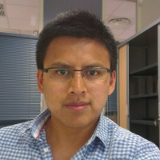Ricardo Omar Chavez-Garcia

Current research
Previous research
Publications
Curriculum vitae
Contact information
I am a researcher working on multi-sensor stochastic methods for robotic semantic perception. My current work focuses on learning sensorimotor representations for scene understanding through the interaction of perception and action processes. I am interested on proposing and developing intelligent systems and robotic platforms that interact with the real world.
Current research
We study the traversability problem for mobile robotics. For example, ground robots operating on unstructured terrain must predict which areas of the environment they are able to pass in order to plan feasible paths. We address traversability estimation for ground robots as a heightmap classification problem: we build a convolutional neural network that, given an image representing the heightmap of a terrain patch, predicts whether the robot will be able to traverse such patch from left to right.
The classifier is trained for a specific wheeled robot model using simulation data on procedurally generated training terrains; the trained classifier can be applied to unseen large heightmaps to yield oriented traversability maps, and then plan traversable paths. We extensively evaluate the approach in simulation on real-world elevation datasets, and run a real-robot validation for indoor and outdoor environments. Data and code to reproduce the results and media material can be found at github.
Related videos:
The National Centre of Competence in Research (NCCR) Robotics
Previous research
Discovering and Manipulating Affordances
We studied and developed sensorimotor representations that fuse perceptual data (scene and parts of the agent), proprioceptive feedback (agent’s own configuration), contextual information (previous knowledge) and the agent’s goals. We shall develop theories about the importance and influence of each input and their fusion for understanding the scene.
We assumed that scene interpretation is necessarily related to learning new objects or adding knowledge about known objects. Hence we shall also study the relationship between interpretation and learning. The learning process will consist in building sensorimotor representations of both scene elements and associated actions.
RoboErgoSum - Self Aware Robots, was a four year project funded by the French National Research Agency ANR which objective is to explore artificial conscienceness in robotics.
The Institute for Intelligent Systems and Robotics (ISIR)
University Pierre et Marie Curie
The National Center for Scientific Research
Multiple Sensor Fusion and Classification for Moving Object Detection and Tracking
I worked on probabilistic and credibilist methods to fuse information from a heterogeneous array of sensors. Three modules were proposed and implemented to work simultaneously in an Advanced Driver Assistant System: multi-target object detection, classification and tracking of multiple objects in dynamic scenarios.
In the framework of perception inside interactIVe (accident avoidance by active intervention for Intelligent Vehicles) IP European Project I proposed and developed a multi-sensor fusion solution software for a frontal object perception application. It involved: outdoor environment mapping; detection, tracking and classification of multiple objects of interest in different driving scenarios. Multiple sensors (lidar, camera and radar) fusion was at the core of the perception task. The solution was part of a whole automotive application involving several car manufacturers and suppliers inside interactIVe project.
Related videos:
Grenoble Informatics Laboratory
Université Grenoble Alpes
Publications
Curriculum vitae
A pdf version is found here
Contact
Dalle Molle Institute for Artificial Intelligence Research (IDSIA)
University of Applied Sciences and Arts of Southern Switzerland (SUPSI)
Università della Svizzera italiana
Galleria 2, Via Cantonale 2c
CH-6928 Manno
Switzerland
omaridsia
ch